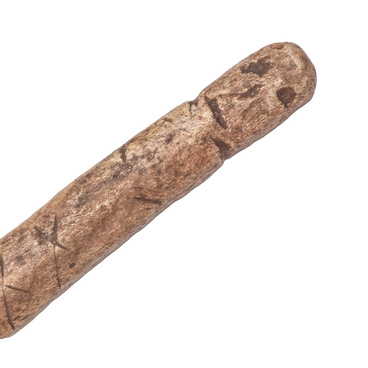The KNMWT 15000 skull model was created in 2018. The original is a part of the skull of Homo erectus, that lived about 1.5 million years ago. A number of researchers attribute the find to another species — Homo ergaster, a working person.
The skull fragment was found by researcher Kamoya Kimeu on the western side of Lake Turkana in Kenya. In August 1984, he was walking along the banks of the seasonal Nariokotome River and saw a small bone the size of a matchbox. An experienced antiquities seeker concluded that the find might belong to an ancestor of a modern man.
Kimeu was a participant in the excavations that were carried out in the vicinity, and after his discovery, scientists found thighbones, skull fragments, teeth and ribs. It turned out that they belonged to one person — this was confirmed by a special analysis of the finds. The archaeologists managed to collect the skeleton of a homo erectus, which gave an idea of the shape and size of the body of one of the species of ancient people.
The skeleton is also called the ‘Turkana Boy’ or ‘Nariokotoma Boy’, since it belonged to a child of 9-12 years old. An enamel analysis showed that he still had baby teeth. The boy Turkana was tall for his age — 1.6 meters. Archaeologists also determined that he had a thin body, well adapted for life in a hot climate.
Homo erectus was one of the most massive representatives of the most ancient people. Despite the fact that he looked like a modern human, the size and structure of his body differed significantly. Therefore, many anthropologists distinguish them into a special genus of pithecanthropus — the oldest human species that preceded the Neanderthal and Sapiens in evolution.
Homo erectus may have been the first ancestor of modern humans to move beyond Africa — about 1.8 million years ago. His remains were found in different parts of the world: in China, Indonesia and Georgia. Researchers believe that there were at least two main geographical branches of this species: western (Afro-European) and eastern (Asian). Among them, there are several types of Homo erectus: Sinanthropus in China, Rudolph man in East Africa, Meganthropus in Java, Pithecanthropus Moorish in North Africa and others.
The skull fragment was found by researcher Kamoya Kimeu on the western side of Lake Turkana in Kenya. In August 1984, he was walking along the banks of the seasonal Nariokotome River and saw a small bone the size of a matchbox. An experienced antiquities seeker concluded that the find might belong to an ancestor of a modern man.
Kimeu was a participant in the excavations that were carried out in the vicinity, and after his discovery, scientists found thighbones, skull fragments, teeth and ribs. It turned out that they belonged to one person — this was confirmed by a special analysis of the finds. The archaeologists managed to collect the skeleton of a homo erectus, which gave an idea of the shape and size of the body of one of the species of ancient people.
The skeleton is also called the ‘Turkana Boy’ or ‘Nariokotoma Boy’, since it belonged to a child of 9-12 years old. An enamel analysis showed that he still had baby teeth. The boy Turkana was tall for his age — 1.6 meters. Archaeologists also determined that he had a thin body, well adapted for life in a hot climate.
Homo erectus was one of the most massive representatives of the most ancient people. Despite the fact that he looked like a modern human, the size and structure of his body differed significantly. Therefore, many anthropologists distinguish them into a special genus of pithecanthropus — the oldest human species that preceded the Neanderthal and Sapiens in evolution.
Homo erectus may have been the first ancestor of modern humans to move beyond Africa — about 1.8 million years ago. His remains were found in different parts of the world: in China, Indonesia and Georgia. Researchers believe that there were at least two main geographical branches of this species: western (Afro-European) and eastern (Asian). Among them, there are several types of Homo erectus: Sinanthropus in China, Rudolph man in East Africa, Meganthropus in Java, Pithecanthropus Moorish in North Africa and others.



